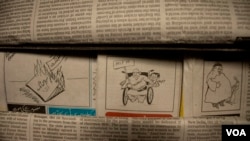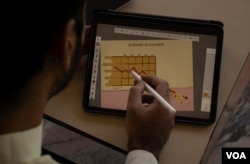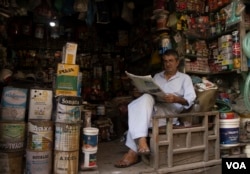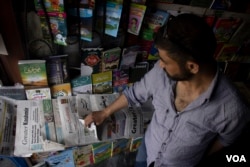Political cartooning, a long-cherished tradition in Indian-administered Kashmir, has lost its bite and much of its relevance in the region because of heightened government scrutiny and self-censorship by publishers, practitioners say.
One popular cartoonist, whose drawings for years graced a local newspaper, said he has not attempted to practice journalism for more than four years because he feels he can no longer make political points as he would like.
“Cartoons serve as a commentary on the news but when the news itself disappears from the papers, cartoons lose their importance,” said the artist, who asked that his name not be published for fear of official retaliation. “I discontinued because I had no free will.”
Throughout three India-Pakistan wars over Kashmir and decades of anti-India militancy, cartoonists in the region used their craft to expose human rights violations, government failures and socio-political struggles.
But several artists and editors told VOA that sort of vibrant commentary has largely disappeared since the government of India stripped Jammu and Kashmir of its autonomous status in 2019 and introduced a new media policy for the region the following year.
That policy, among other things, empowers authorities in Kashmir to accredit journalists and news outlets, distribute government advertising and determine what constitutes false news or incitement.
The 50-page policy document cites “law and order and security considerations” in the region, where it says militants have been “fighting a proxy war supported and abetted from across the border” in Pakistan. Therefore, it says, it is “extremely important that the efforts of anti-social and anti-national elements to disturb the peace are thwarted.”
“Regional newspapers depend on government advertisements for revenue because of the weak private sector, making it difficult for us to run the organization,” said the editor-in-chief of one local newspaper, who like others interviewed for this article asked that his name not be published for fear of reprisals.
“None of the owners dares to publish content that questions government assertions or else their publication will lose rights to carry government advertisements,” the editor said. “Public relations has replaced journalism since 2019 as government press releases and events get space on front pages.”
The editor of another newspaper said in an interview that cartoons, sarcasm or dark humor have traditionally been used by artists to critique power when other kinds of reporting faced censorship.
“We have witnessed the same phenomenon in [Jammu and Kashmir] through the artistic expressions of BAB,” he said, using the initials of a veteran cartoonist. “For decades he conveyed the dissenting voice of the people through his cartoons; as a result, he faced problems on many occasions by the successive governments.”
BAB, or Bashir Ahmad Bashir, is also the editor-in-chief of a popular Urdu language newspaper, Srinagar Times. His cartoons are believed to be the chief selling point of his publication. Throughout his decades-long career, BAB has used satirical illustrations to convey messages during the times of censorship.
“I feel that the tolerance for criticism has reached an all-time low,” said the second unidentified editor. “It appears that there is no space for critical expression, whether through news, articles, opinions or even concealed within forms of art, music and political cartoons.
“The democratic ideals and the foundational principle of free speech in a democratic nation like India appear to be fading.”
Minga Sherpa, director of the Department of Information and Public Relations, told VOA that there is no truth to the claims that there is no space for critical expression in Jammu and Kashmir.
“These are merely allegations without any substance,” Sherpa said. However, he abruptly disconnected the call when questioned about the new media policy implemented by his department that, according to editors, forces publishers to impose self-censorship to retain government advertisements.
A former journalism student who asked not to be identified told VOA that there is a distinct contrast between the cartoons published before 2019 and those seen today.
“I analyzed the cartoons published prior to 2019 and I find them to be powerful. They highlighted multiple issues including human rights violations, government failures, social issues and political struggles,” the former student said. “However, contemporary cartoons no longer emphasize political issues or human rights violations.”
He said only a handful of newspapers now publish cartoons.
“Even though political cartoons feature in some papers, their theme revolves around local politicians who no longer are in power,” the former student said. “Moreover, some political cartoons also delve into matters concerning other countries.”
Bashir Ahmad Bashir was approached for his comments, but he declined to be interviewed.
Mir Suhail, a Kashmir-born U.S.-based political cartoonist affiliated with the Indian American Muslim Council, or IAMC, spoke about the reports of a decline in his craft in Kashmir.
“Critique plays an important role in a democracy as it serves the interests of the common people,” Mir said in an interview. “Art goes above language barriers making it accessible to a wider audience.”












